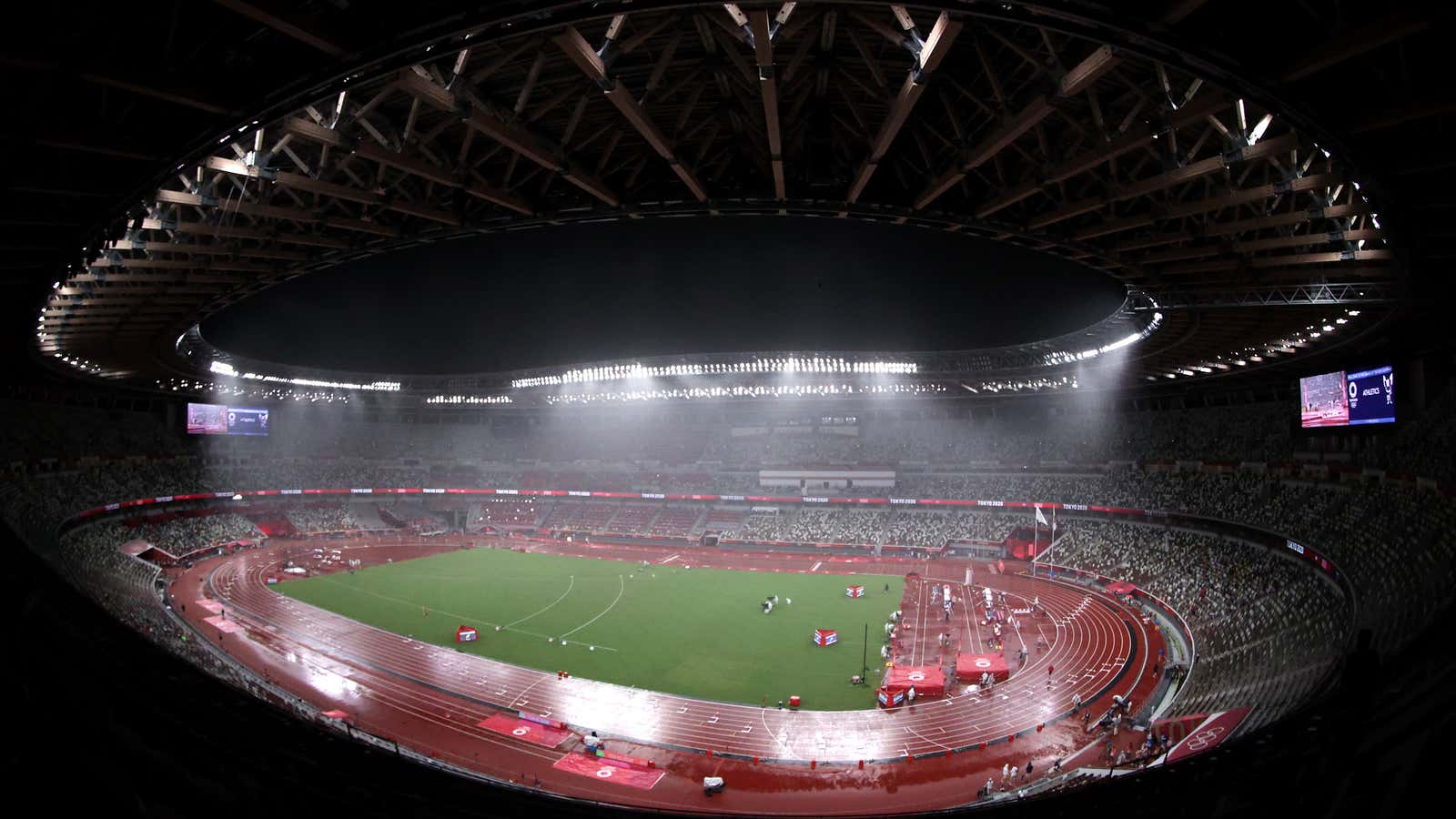The organizers of the Tokyo Olympics made a bold claim before the Games. In a June report on the event’s environmental footprint, they said the event would be not only carbon neutral, but carbon negative. To that end, they have solicited the donation of nearly twice the volume of carbon offset credits as the event itself—including the construction of buildings, electricity consumption, travel by athletes, even the recycled metal used to manufacture the medals—would produce.
It’s an impressive feat, given that the event’s estimated carbon footprint—2.3 million metric tons of CO2—is equal to the annual emissions from about half a million cars. The task was made a bit easier by the decision not to allow spectators from overseas because of Covid-19, which the organizers estimate cut emissions by about 12%. Still, some carbon market experts are skeptical that the claim is really credible.
How the Tokyo Olympics tried to go carbon negative
The offset credits collected by the Olympics were taken from cap-and-trade markets run by the regional governments of Tokyo and Saitama (a prefecture that covers the capital city’s northwest suburbs). These markets were set up in 2010 with the aim of reducing emissions from the cities’ largest commercial buildings and industrial facilities to 30% below 2000 levels by 2030. Each facility was given an allocation of credits; any that were unneeded after the facility undertook emissions-reduction measures like installing more efficient climate control or lighting systems could be sold to higher-emitting facilities.
The system worked well at first; by the end of the first compliance period, in 2014, emissions were already down 25%. Surplus credits that were unsold at the end of that period could be banked for future periods; these surplus credits made up the bulk of what was donated to the Olympics, said Masako Konishi, director of conservation and energy at World Wildlife Fund Japan and a member of the Olympics’ sustainability committee.
In theory, those donations should have meant that donor facilities would be able to emit that much less in the future, thus offsetting new emissions from the Olympics. And Konishi said that in order to be donated to the Olympics, the credits needed to pass a rigorous verification test. But in the last few years, the Tokyo and Saitama carbon markets appear to have become saturated with excess credits as the government-appointed “cap” remains high relative to the emission reductions facilities have already achieved.
The pace of emissions reductions has stalled—it’s stuck at 27% since 2017, according to government data. And the price to emit one ton of CO2 has fallen dramatically, from $95 in 2014 to just $5 in 2020—an indication that there are far too many credits sloshing around (the price in the European Union carbon market, by comparison, is above $50). The upshot is that there’s a good chance the credits that were donated to the Olympics might never have been used in any case, says Guy Turner, CEO of the carbon market consultancy Trove Research.
“You could argue that these allowances might still be used in the future, and hence taking them out of the system now actually leads to a reduction in the future,” said Gilles Dufrasne, a policy officer at Carbon Market Watch, a Brussels think tank. “But you could also argue that this surplus was created by excess allocation in the first place, and so using them to claim neutrality now is basically exploiting a policy mistake from the past to green the image of an activity today.”
The Olympics are still too big to be sustainable
Even setting aside the carbon footprint question, the Tokyo Games are representative of an overall declining level of sustainability in the Olympics over time, according to an April 19 paper in the journal Nature by geographers at the University of Lausanne.
The economists developed an index for estimating the sustainability of every Olympics since 1992 in three categories: Ecological, social, and financial.
The social and financial categories included metrics like population displacement and what share of the event’s budget was covered by local taxpayers. The ecological category focused on the event’s physical size, the number of attendees, and the what share of buildings were new builds. Carbon footprint wasn’t a factor, said Sven Daniel Wolfe, one of the paper’s authors, because measurement and reporting of emissions was inconsistent between events, and sometimes used dubious methods.
Wolfe and his colleagues found a declining level of sustainability across all three categories, despite the fact that sustainability has been an official core tenet of the International Olympic Committee since 2014. The ecological metric fell the fastest, and put the Tokyo Olympics on par with the infamously destructive Sochi winter Olympics in 2014. In addition to the event’s size and $3 billion new construction price tag, Daniels cited reports by WWF and the Rainforest Action Network finding that the event sourced wood, palm oil, and other natural materials from suppliers that contribute to unsustainable deforestation.
To its credit, Wolfe said, the IOC has tried to promote sustainability in its city selection criteria by relaxing a longstanding rule that all facilities must be situated within one perimeter (allowing for distributed facilities raises the odds that existing buildings can be repurposed), and restricting the construction of one-function, rather than multipurpose, venues that become useless eyesores after the games conclude.
But ultimately, Wolfe said, the IOC’s power is limited, and it’s up to local governments to take the initiative—which starts with scrapping the bigger-is-better ethos that cities still cling to when they find themselves on the global stage.
“There’s a politics of spectacle in which every event has to be bigger and flashier,” Wolfe said. “We need a radical rethink of how the games are run if we want them to be compatible with our definition of sustainability.”
